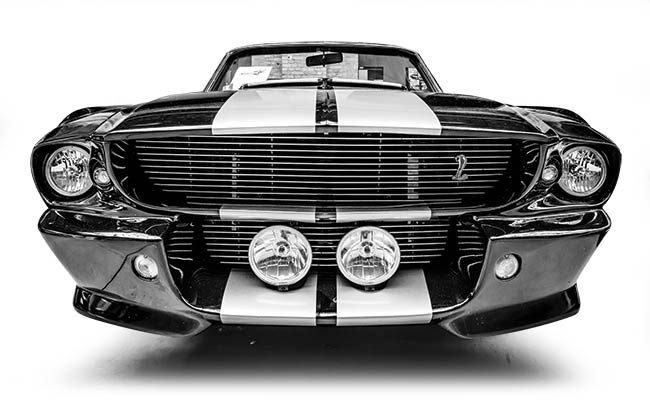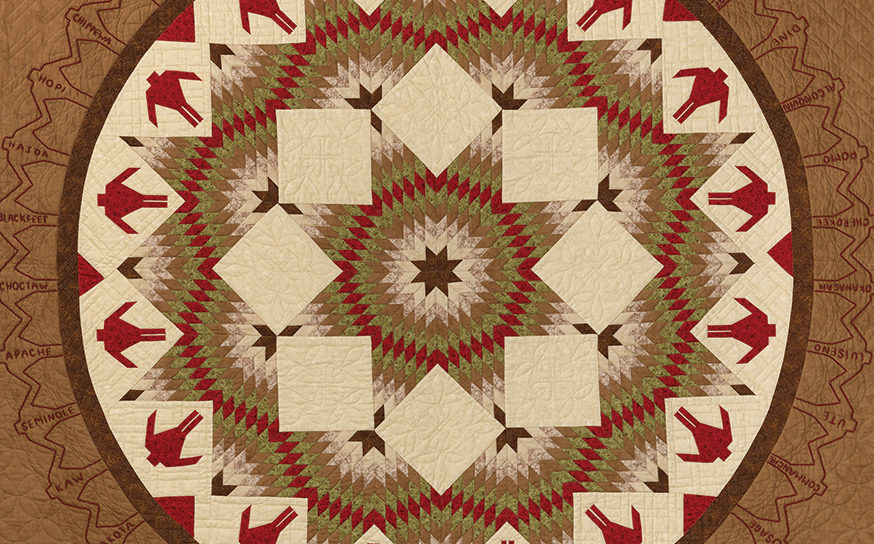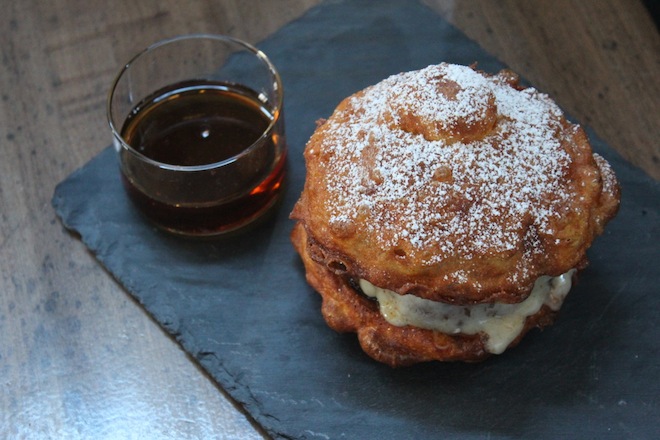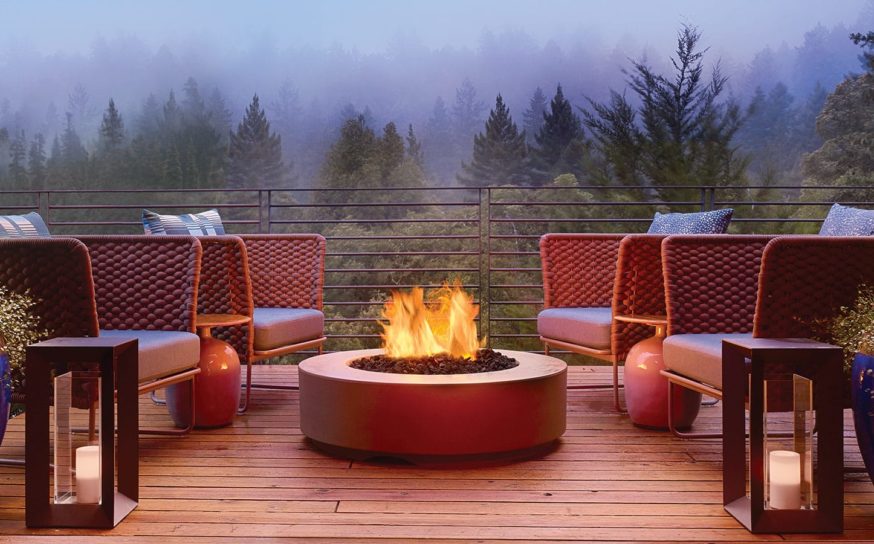
Mustang Love
The story of how one of the most prolific and beloved cars in the world powered the phenomenal success of a local dealership.
-
CategoryUncategorized
-
Written byMichael Ventre
To some it may seem a bit strange that he remembers the date, but on April 17, 1964, Bert Boeckmann first laid eyes on the Ford Mustang. It was love—and lust—at first sight, plus that “ca-ching” cash register sound going off in his head.
“We had a white one with red interior over at the dealership in San Fernando,” recalls the 84-year-old CEO of Galpin Ford, now located in North Hills. “I thought, ‘I’ll do well with that.’ And we did exceedingly well. Over a period of time we became the #1 seller of Mustangs in the United States.”
The Mustang was new to car dealerships. Bert wasn’t. The Mustang celebrates its 50th anniversary this year. Bert’s association with Galpin Ford goes back even farther, to 1953 when he landed a job there as a sales rep.

GREEN MACHINE: Bert and Beau Boeckmann alongside a 1969 Mustang built by the Galpin crew.
After then-owner Frank Galpin detected rivals sniffing around his star salesman, he launched a preemptive strike by pro-moting Bert to assistant manager and then general manager, also giving him a piece of the proceeds.
Bert was wildly successful, and by 1968 he bought out Galpin and became owner of the company. He credits his rapid rise to his willingness to expend more elbow grease than the competition.
“I worked all but two days that year,” he explains. “I went in at 8:30 in the morning and went home at 8:00 at night. I took no time off. I just did it.”
Bert, who resides in the northwest Valley, ambles his way to his office on the second floor above the Galpin showroom. The well-respected executive is slower-moving these days—but still sharp. On the wall there is a memento from Arnold Schwarzenegger that says, “Thanks for the Heavy Lifting.”
There are candy jars here and there, much like your grandparents might have had. Bert’s wife, Jane, is prominently displayed in a photo from 1969, driving a Mustang in a rally attempting to break the 24-hour land-speed record.

Mustang designer Carroll Shelby.
Jane also works at Galpin as secretary and treasurer. So do two of Bert’s sons. Beau was just named president and chief operating officer of the company. Brett is a VP who handles information analysis. Bert’s eldest son retired from the business this year; his two daughters are not part of the operation.
Despite passing the baton to Beau, Bert, as CEO, remains omnipotent here. It’s as difficult to pry him out of his desk chair and make him put down sales reports as it was when he was first “making his bones” in the ‘50s.
And there is the unmistakable presence of the Ford Mustang just about everywhere. There are several new models in the showroom and on the lot, of course. But in a nearby storeroom is something even more interesting to Mustang aficionados: visors signed by renowned designer Carroll Shelby.
Shelby died in 2012, but not before establishing himself as a maker of masterpieces. A former World War II test pilot and racing driver, he designed his own version of the Mustang and worked with Ford beginning in 1965 on customized editions of the sporty and soon-to-be-iconic chariot. He collaborated often with the late Ron Hornaday, Sr., a star NASCAR driver who was also Galpin’s service manager at the time.
Over the years, the Shelby Mustang appeared often in popular culture. Kevin Costner drove a 1968 GT350 Shelby in the 1988 film Bull Durham, and in 2000 Nicolas Cage sped around in a ’67 GT500 in the remake of Gone in 60 Seconds—just to name two.
Perhaps the most famous movie Mustang, though, was the one Steve McQueen drove in the classic chase scene from the 1968 crime drama Bullitt. That was not a Shelby but rather a 390 Highland Green 1968 Mustang GT Fastback. Ford provided two renditions for the film. McQueen, incidentally, was a Galpin customer, Bert proudly shares.
Early on, Shelby and Galpin Ford established a close association (that lasted until Shelby’s passing) based on a mutual love for a certain make of auto. But it was more than that. Shelby was an innovator, and at Galpin he found kindred spirits.
Today one of Galpin’s most successful divisions is its motor sports customization business, Galpin Auto Sports, where Shelby devotees as well as like-minded individuals interested in creating something unique on four wheels flock to explore possibilities.

Inside Galpin Auto Sports, which houses 50 vehicles.
“We were the first Shelby dealer in California,” 44-year-old Beau explains. “The Mustang is so individual. It lends itself to customizing, both cosmetically and performance-wise. With the Mustang you can ‘make it your way,’ to steal a popular term. People fit a Mustang individually to themselves. That’s by far our most customized vehicle, and by far it has the most areas to customize on it. It lends itself to personalize, to customize and to go faster and stop faster and handle better.”
He adds, “Also, we have what we call the Shelby Mod Shop, where we can make modifications to Shelbys.”
Bert understood synergy, combining his connection to both Ford and Shelby to dominate the Mustang market. “There were so many things we could do with it,” he explains. “(Shelby) went to two dealers in the United States, and he always gave credit to making him a successful person in business—myself and Bob Tasca on the East Coast (in Rhode Island).”

RED MIST: A worker polishes a 2008 Mustang GT built for the movie Kick-Ass.
Bert continues, “I went to a show in Las Vegas once, and I didn’t even know until I got there that we (he and Shelby) were doing an interview together. He said, ‘You know I wouldn’t be here if it wasn’t for Bert Boeckmann and Bob Tasca. They’re really the ones who stood up and bought my cars from me.’ So from that time we always had fun with the Mustang, and we did a lot with it. We had a pink sale. Pink Mustangs with whitewall tires and a white top. We did the painting on them. They were beautiful. We got 50 of them, and they sold big. Women loved them. We always had fun with that car. It was always a leader in what we did.”
The Mustang was a hit when it was released in 1964, and through the past half-century it has experienced steady sales. There have been a few noteworthy dips though: a period in the ‘70s when consumers drifted toward smaller cars, as well as the late-1980s into the early-‘90s. At one point, Ford even had plans to scrap it for the Probe, but it survived.
When Ford discontinued the Mustang convertible in 1980, Galpin continued to produce its own version of the car. As Galpin’s publicist, Nathan Hoyt, tells it, Galpin’s product was so successful, upon seeing it Ford’s then-chairman Phil Caldwell shipped one back to Detroit, and soon Ford was selling convertibles again.


THE ULTIMATE RIDE: A vintage Ford advertisement.
Now on its fifth generation, it is still a popular model. Later this year Ford will release 1,964 of its anniversary editions, which is somewhat of a problem considering there are more than 4,000 Ford dealerships in the country. “We’ll get very few,” Beau laments.
So why the lasting appeal? “When the Ford Mustang launched in 1964, it instantly became a success,” explains Jacob Brown, veteran automotive writer and Mustang expert. “Part of that was attributable to being the right car at the right time: Baby Boomers wanted fun, sporty cars that could be had for relatively little money (in those days a new Mustang went for about $2,400). The car appealed to style-conscious shoppers who previously didn’t have an affordable option all the way up to go-fast weekend racers who wanted bigger engines and sportier setups.”
Brown notes that even though a half-century has gone by since the car was first introduced, and the classic Mustangs and Shelby Mustangs on display at Galpin—as well as the ones lent to the Petersen Automotive Museum for its “Mustang Madness” exhibit—look a lot slimmer and sleeker than their more muscular brethren of today, the essence of the car remains the same.
“Fundamentally, the Mustang hasn’t changed over the last 50 years,” he says. “It’s still a car for fun and free-spirited people. But now it’s more expensive (a new Mustang costs about 10 times as much as it did in 1964), more mature and certainly a lot more niche than it was when American cars ruled the road in the ‘60s.”
While Japanese cars and others have tempted customers away from American car brands over the years, many customers like Craig Cunningham have remained loyal. The 76-year-old retired UCLA professor currently serves as president of the Mustang Owners Club of California, which has about 300 members and meets once a month in Canoga Park.
Cunningham says his was the very first Mustang Club in the nation. Back in 1966, when Galpin made its move from San Fernando to North Hills, the Mustang Club helped the dealership move all its inventory and equipment. The two entities have had a close friendship since. Galpin sponsors the club at dinners and events and supplies trophies for competitions and car shows, including one set to take place on September 14
To Cunningham, who bought his first Mustang in 1965, the enduring appeal of the feisty, four-wheeled equine is obvious. “The why of the Mustang is the sportiness of it. Originally it was a sporty-looking car that was priced very competitively. You could buy one for $2,400 and be the talk of the neighborhood and the town. It also performed well and had a lot of options. It met everybody’s criteria, whether they had a million bucks or if they had a standard job. The affordability of the Mustang is still true today.”
Those obsessed with Mustangs aren’t limited to gear-headed codgers stuck in the ‘60s, Cunningham notes. “I do a lot of car shows, and we see younger people who have purchased early Mustangs. We also see a lot of them today who have late-model Mustangs—2006s through ‘14s.”
Strolling around the three-block-long Galpin property along both sides of Roscoe Boulevard is a workout. The company sells vehicles out of 11 buildings in all, including Galpin Mazda and Galpin Jaguar. Galpin Auto Sports, across the street, houses some eye-popping Mustangs as well as concept cars and other famous vehicles like Liberace’s “candelabra’ed” ride. Tours are available by reservation.
Galpin also has its own restaurant on-site, as well as its own Starbucks. And everybody seems to know everybody, from the security guards to the administrative assistants to the sales people to the customers.
“People just keep coming back here to buy their cars,” Bert’s son, Brett, says. “We get people who come in who say, ‘My father bought Fords from you,’ or ‘My grandfather bought Fords from you.’ My dad created a family type of atmosphere where customer loyalty is key.”
Reflecting on the past 50 years in the driver’s seat, Bert indicates it’s been a two-way street. “It’s still a lot of fun. It’s always been a fun business.”











